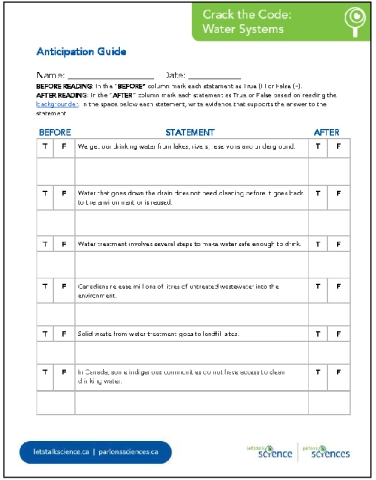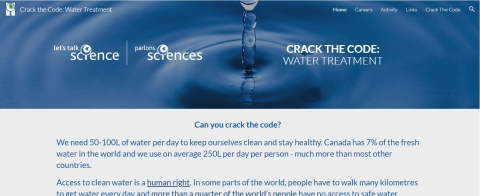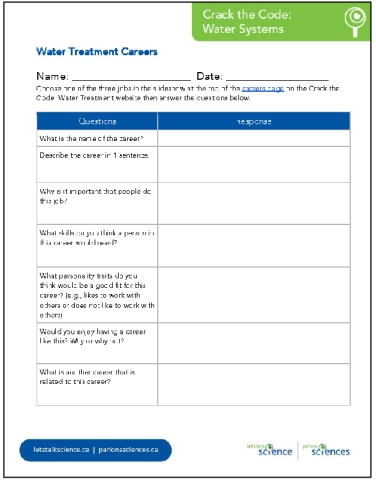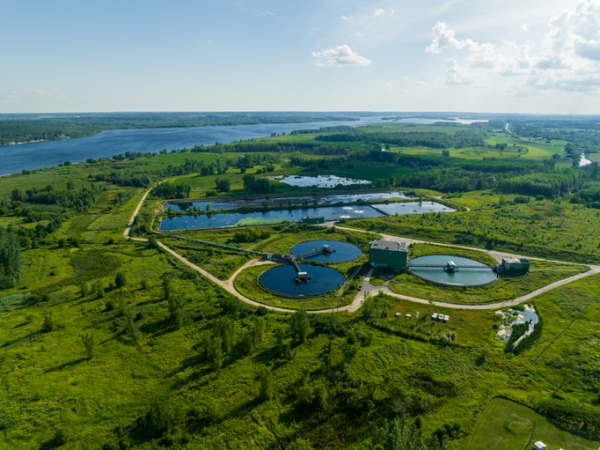Crack the Code: Water Treatment

Checking the inside of a pipe (101cats, iStockphoto)

Checking the inside of a pipe (101cats, iStockphoto)
How does this align with my curriculum?
Curriculum Alignment
AB
8
Knowledge and Employability Science 8, 9 (revised 2009)
Unit E: Freshwater and Saltwater Systems
BC
11
Science for Citizens 11 (June 2018)
Big Idea: Scientific understanding enables humans to respond and adapt to changes locally and globally.
BC
12
Environmental Science 12 (June 2018)
Big Idea: Human actions affect the quality of water and its ability to sustain life.
NS
7
Science Grade 7 (2020)
Learners will analyse particle theory in relation to substances in environments
NU
8
Knowledge and Employability Science 8 (Alberta, Revised 2009)
Unit E: Freshwater and Saltwater Systems
ON
11
Environmental Science, Grade 11, University/College (SVN3M)
Strand C: Human Health and the environment
YT
12
Environmental Science 12 (British Columbia, June 2018)
Big Idea: Human actions affect the quality of water and its ability to sustain life.
YT
11
Science for Citizens 11 (British Columbia, June 2018)
Big Idea: Scientific understanding enables humans to respond and adapt to changes locally and globally.
NT
8
Knowledge and Employability Science 8 (Alberta, Revised 2009)
Unit E: Freshwater and Saltwater Systems
AB
8
Career and Technology Foundations (CTF) (revised 2019)
CTF is exploring interests, passions and skills while making personal connections to career
possibilities.
AB
8
Career and Technology Foundations (CTF) (revised 2019)
CTF is working independently and with others while exploring careers and technology.
AB
9
Career and Technology Foundations (CTF) (revised 2019)
CTF is exploring interests, passions and skills while making personal connections to career
possibilities.
AB
9
Career and Technology Foundations (CTF) (revised 2019)
CTF is working independently and with others while exploring careers and technology.
ON
11
Communications Technology, Grade 11 University/College Preparation (TGJ3M) (2009)
Strand D: Professional Practices and Career Opportunities
ON
12
Communications Technology, Grade 12 (TGJ4M) (2009)
Strand D: Professional Practices and Career Opportunities
ON
11
Computer Engineering Technology, Grade 11, University/College Preparation (TEJ3M) (2009)
Strand D: Professional Practices and Career Opportunities
ON
12
Computer Engineering Technology, Grade 12, University/College Preparation (TEJ4M) (2009)
Strand D: Professional Practices and Career Opportunities
ON
11
Transportation Technology, Grade 11, College Preparation (TTJ3C) (2009)
Strand D: Professional Practices and Career Opportunities
ON
12
Transportation Technology, Grade 12, College Preparation (TTJ4C) (2009)
Strand D: Professional Practices and Career Opportunities
ON
11
Manufacturing Engineering Technology, Grade 11, University/College Preparation (TMJ3M) (2009)
Strand D: Professional Practices and Career Opportunities
ON
12
Manufacturing Engineering Technology, Grade 12, University/College Preparation (TMJ4M) (2009)
Strand D: Professional Practices and Career Opportunities
ON
11
Hospitality and Tourism, Grade 11, College Preparation (TFJ3C)(2009)
Strand D: Professional Practices and Career Opportunities
ON
12
Hospitality and Tourism, Grade 12, College Preparation (TFJ4C) (2009)
Strand D: Professional Practices and Career Opportunities
ON
11
Health Care, Grade 11, University/College Preparation (TPJ3M) (2009)
Strand D: Professional Practices and Career Opportunities
ON
12
Health Care, Grade 12, University/College Preparation (TPJ4M) (2009)
Strand D: Professional Practices and Career Opportunities
ON
11
Hairstyling and Aesthetics, Grade 11, Workplace Preparation (TXJ3E) (2009)
Strand D: Professional Practices and Career Opportunities
ON
12
Hairstyling and Aesthetics, Grade 12, Workplace Preparation (TXJ4E) (2009)
Strand D: Professional Practices and Career Opportunities
ON
11
Green Industries, Grade 11, University/College Preparation (THJ3M) (2009)
Strand D: Professional Practices and Career Opportunities
ON
12
Green Industries, Grade 12, University/College Preparation (THJ4M) (2009)
Strand D: Professional Practices and Career Opportunities
ON
9
Exploring Technologies, Grade 9, Open (TIJ1O) (2009)
Strand D: Professional Practices and Career Opportunities
ON
11
Construction Engineering Technology, Grade 11, College Preparation (TCJ3C) (2009)
Strand E: Professional Practices and Career Opportunities
ON
12
Construction Engineering Technology, Grade 12, College Preparation (TCJ4C) (2009)
Strand E: Professional Practices and Career Opportunities
BC
8
Career Education 8 (2016)
Big Idea: Our career paths reflect the personal, community, and educational choices we make.
BC
9
Career Education 9 (2016)
Big Idea: Our career paths reflect the personal, community, and educational choices we make.
BC
10
Career-Life Education (2018)
Big Idea: Career-life choices are made in a recurring cycle of planning, reflecting, adapting, and deciding.
BC
11
Career-Life Connections (2018)
Big Idea: Career-life development includes ongoing cycles of exploring, planning, reflecting, adapting, and deciding.
BC
11
Career-Life Education (2018)
Big Idea: Career-life choices are made in a recurring cycle of planning, reflecting, adapting, and deciding.
BC
12
Career-Life Connections (2018)
Big Idea: Career-life development includes ongoing cycles of exploring, planning, reflecting, adapting, and deciding.
BC
12
Career-Life Connections (2018)
Big Idea: Career-life decisions influence and are influenced by internal and external factors, including local and global trends.
BC
12
Career-Life Connections (2018)
Big Idea: Engaging in networks and reciprocal relationships can guide and broaden career-life awareness and options.
BC
12
Career-Life Connections (2018)
Big Idea: Lifelong learning and active citizenship foster career-life opportunities for people and communities.
BC
8
Career Education 8 (2016)
Big Idea: Reflecting on our preferences and skills helps us identify the steps we need to take to achieve our career goals.
BC
8
Career Education 8 (2016)
Big Idea: The value of work in our lives, communities, and society can be viewed from diverse perspectives.
BC
8
Career Education 8 (2016)
Big Idea: Achieving our learning goals requires effort and perseverance.
BC
8
Career Education 8 (2016)
Big Idea: Adapting to economic and labour market changes requires flexibility.
BC
11
Career-Life Connections (2018)
Big Idea: Career-life decisions influence and are influenced by internal and external factors, including local and global trends.
BC
11
Career-Life Connections (2018)
Big Idea: Engaging in networks and reciprocal relationships can guide and broaden career-life awareness and options.
BC
11
Career-Life Connections (2018)
Big Idea: Lifelong learning and active citizenship foster career-life opportunities for people and communities.
BC
9
Career Education 9 (2016)
Big Idea: Reflecting on our preferences and skills helps us identify the steps we need to take to achieve our career goals.
BC
9
Career Education 9 (2016)
Big Idea: The value of work in our lives, communities, and society can be viewed from diverse perspectives.
BC
9
Career Education 9 (2016)
Big Idea: Achieving our learning goals requires effort and perseverance.
ON
10
Career Studies Grade 10, OPEN (GLC2O) (2019)
Strand B. Exploring and Preparing for the World of Work
ON
10
Career Studies Grade 10, OPEN (GLC2O) (2019)
Strand C. Planning and Financial Management to Help Meet Postsecondary Goals
ON
10
Career Studies Grade 10, OPEN (GLC2O) (2019)
Strand A. Developing the Skills, Strategies, and Habits Needed to Succeed
YT
8
Career Education 8 (2016)
Big Idea: Our career paths reflect the personal, community, and educational choices we make.
YT
8
Career Education 8 (2016)
Big Idea: Reflecting on our preferences and skills helps us identify the steps we need to take to achieve our career goals.
YT
8
Career Education 8 (2016)
Big Idea: The value of work in our lives, communities, and society can be viewed from diverse perspectives.
YT
8
Career Education 8 (2016)
Big Idea: Achieving our learning goals requires effort and perseverance.
YT
8
Career Education 8 (2016)
Big Idea: Adapting to economic and labour market changes requires flexibility.
YT
9
Career Education 9 (2016)
Big Idea: Reflecting on our preferences and skills helps us identify the steps we need to take to achieve our career goals.
YT
9
Career Education 9 (2016)
Big Idea: The value of work in our lives, communities, and society can be viewed from diverse perspectives.
YT
9
Career Education 9 (2016)
Big Idea: Our career paths reflect the personal, community, and educational choices we make.
YT
9
Career Education 9 (2016)
Big Idea: Achieving our learning goals requires effort and perseverance.
YT
9
Career Education 9 (2016)
Big Idea: Adapting to economic and labour market changes requires flexibility.
YT
10
Career-Life Education (2018)
Big Idea: Career-life choices are made in a recurring cycle of planning, reflecting, adapting, and deciding.
YT
11
Career-Life Connections (2018)
Big Idea: Career-life development includes ongoing cycles of exploring, planning, reflecting, adapting, and deciding.
YT
11
Career-Life Connections (2018)
Big Idea: Career-life decisions influence and are influenced by internal and external factors, including local and global trends.
YT
11
Career-Life Connections (2018)
Big Idea: Engaging in networks and reciprocal relationships can guide and broaden career-life awareness and options.
YT
11
Career-Life Connections (2018)
Big Idea: Lifelong learning and active citizenship foster career-life opportunities for people and communities.
YT
11
Career-Life Education (2018)
Big Idea: Career-life choices are made in a recurring cycle of planning, reflecting, adapting, and deciding.
YT
12
Career-Life Connections (2018)
Big Idea: Career-life development includes ongoing cycles of exploring, planning, reflecting, adapting, and deciding.
YT
12
Career-Life Connections (2018)
Big Idea: Career-life decisions influence and are influenced by internal and external factors, including local and global trends.
YT
12
Career-Life Connections (2018)
Big Idea: Engaging in networks and reciprocal relationships can guide and broaden career-life awareness and options.
YT
12
Career-Life Connections (2018)
Big Idea: Lifelong learning and active citizenship foster career-life opportunities for people and communities.
NS
8
Science Grade 8 (2020)
Learners will analyse how the characteristics of cells relate to the needs of organisms.
NS
8
Science Grade 8 (2020)
Learners will evaluate ways to maintain and factors that disrupt cell and system health.
NU
8
Knowledge and Employability Science 8 (Alberta, Revised 2009)
Unit C: Light and Optical Systems
YT
8
Science Grade 8 (British Columbia, June 2016)
Big Idea: Life processes are performed at the cellular level.





